Experimental Investigations of the Behavior of Stiffened Perforated Cold-Formed Steel Sections Subjected to Axial Compression
Abstract
:1. Introduction
- Studying the presence of triangular and circular openings on the behavior and capacity of columns (PCFS) experimentally, with upright members, stiffened or non-stiffened.
- Studying the applicability of using the direct strength method (DSM) to evaluate the efficiency of these sections and the sort of buckling that causes the collapse.
2. Experimental Program
2.1. Material Properties
2.2. Specimens
2.3. Test Setup and Instrumentations
3. Test Results and Analysis
3.1. Load-Displacement Curves
3.2. Buckling Failure Modes
3.3. The Normalized Ultimate Compression Strength Ratio
4. Comparison between Direct Strength Method and Experimental Test
5. Conclusions
- Distortional buckling (D.B.) is the mode of failure for specimens that have a maximum slenderness ratio (λmax < 45)
- The distortional–global buckling interaction (DB + GB) dominates the buckling modes of specimens that have a height equal to 1500 and 2000 mm, with section thickness equal to 1.5 mm, where a high value of a maximum slenderness ratio (45 < λmax < 75) with a low ratio of compactness.
- The collapse of the specimen occurs due to the effect of global buckling (G.B.) alone when the maximum slenderness ratio is high (λmax ≥ 89.5), and the section is classified as a non-compact section.
- The normalized ultimate compression strength ratio (Pu,exp./Py) for all specimens ranged from 0.37 to 1.03, according to the value of the slenderness ratio and the compactness ratio. It was smaller than unity for all specimens, unless the maximum slenderness ratio was small (λmax ≤ 18.7), and the section was classified as a non-compact section.
- The web height has a marginal effect on the percentage increase in ultimate axial compression capacity when the web increases from 90 mm to 110 mm, compared to the increase in cross-section area for all lengths. This increase is attributed to the percentage increase in ultimate capacity, ranging from 7.1% to 12.2%, and less than the percentage increase in the cross-section area, which equals 13.6%.
- The web-thickness ratio is the major factor influencing the ultimate axial compression capacity. When the web height is constant and the plate thickness increases, the web-thickness ratio decreases, and the ultimate axial compression capacity increases for all specimen lengths.
- The results of this study explicitly show that the direct strength method (DSM) has been demonstrated to be unreliable for predicting the ultimate strength of uprights failing in buckling interactions for perforated uprights.
- The failure modes of perforated specimens with stiffeners generally cannot be well predicted by the direct strength method.
- The findings of this study reveal that the direct strength method (DSM) modification carried out by Xianzhong Zhao et al. is more accurate than DSM. Nevertheless, the results are exaggerated compared to the experimental results for many specimens, so a more precise and comprehensive numerical study with many models is needed, to develop a perfect equation that can be used to calculate the ultimate strength of perforated uprights.
6. Patents
Author Contributions
Funding
Data Availability Statement
Acknowledgments
Conflicts of Interest
References
- Casafont, M.; Pastor, M.; Roure, F.; Pekoz, T. An experimental investigation of distortional buckling of steel storage rack columns. Thin-Walled Struct. 2011, 49, 933–946. [Google Scholar] [CrossRef]
- Zhao, X.; Ren, C.; Qin, R. An experimental investigation into perforated and non-perforated steel storage rack uprights. Thin-Walled Struct. 2017, 112, 159–172. [Google Scholar] [CrossRef]
- Rhodes, J.; Schneider, F. The compressional behavior of perforated elements. In Proceedings of the CCFSS International Specialty Conference on Cold-Formed Steel Structures 6, Saint Louism, MI, USA, 18 October 1994. [Google Scholar]
- Crisan, A.; Ungureanu, V.; Dubina, D. Behaviour of cold-formed steel perforated sections in compression. Part 1—Experimental investigations. Thin-Walled Struct. 2012, 61, 86–96. [Google Scholar] [CrossRef]
- EN 15512; The European Standard for Steel Static Storage Systems—Adjustable Pallet Racking Systems. European Standards: Pilsen, Czech Republic, 2020.
- Roure, F.; Pastor, M.; Casafont, M.; Somalo, M. Stub column tests for racking design: Experimental testing, F.E. analysis, and EC3. Thin-Walled Struct. 2011, 49, 167–184. [Google Scholar] [CrossRef]
- Sivakumaran, K.S. Load capacity of uniformly compressed cold-formed steel section with punched web. Can. J. Civ. Eng. 1987, 14, 550–558. [Google Scholar] [CrossRef]
- Moen, C.D.; Schafer, B.W. Experiments on cold-formed steel columns with holes. Thin-Walled Struct. 2008, 46, 1164–1182. [Google Scholar] [CrossRef]
- Banwait, A.S. Axial Load Behavior of Thin-Walled Steel Sections with Openings. Ph.D. Thesis, Department of Civil and Environmental Engineering, Mc.Master University, Hamilton, ON, Canada, 1987. [Google Scholar]
- Baldassino, N.; Hancock, G. Distortional buckling of cold-formed steel storage rack sections including perforations. In Proceedings of the 4th International Conference on Steel and Aluminum Structures, Espoo, Finland, 20–23 June 1999. [Google Scholar]
- Kwon, Y.B.; Kim, B.S.; Hancock, G.J. Compression tests of high strength cold-formed steel channels with buckling interaction. J. Constr. Steel Res. 2009, 65, 278–289. [Google Scholar] [CrossRef]
- Xiang, Y.; Zhou, X.; Shi, Y.; Xu, L.; Xu, Y. Experimental investigation and finite element analysis of cold-formed steel channel columns with complex edge stiffeners. Thin-Walled Struct. 2020, 152, 106–120. [Google Scholar] [CrossRef]
- Schafer, B.W.; Peköz, T. Computational modeling of cold-formed steel: Characterizing geometric imperfections and residual stresses. J. Constr. Res. 1998, 47, 193–210. [Google Scholar] [CrossRef]
- AISI-S100; North American Specification for the Design of Cold-Formed Steel Structural Members. American Iron, and Steel Institute: Washington, DC, USA, 2016.
- AS/NZS4600; Cold-Formed Steel Structures. Standards Australian/New Zealand: Wellington, New Zealand, 2018.
- Moen, C.D.; Schafer, B.W. Elastic buckling of cold-formed steel columns and beams with holes. Eng. Struct. 2009, 31, 2812–2824. [Google Scholar] [CrossRef]
- Yao, X.; Guo, Y.; Liu, Y.; Su, J.; Hu, Y. Analysis on distortional buckling of cold-formed thin-walled steel lipped channel steel members with web openings under axial compression. Indian Concr. J. 2020, 50, 170–177. (In Chinese) [Google Scholar]
- ECP 205; Egyptian Code Practice for Steel Construction and Bridges—Allowable Stress Design. Housing and Building National Research Center: Cairo, Egypt, 2001.

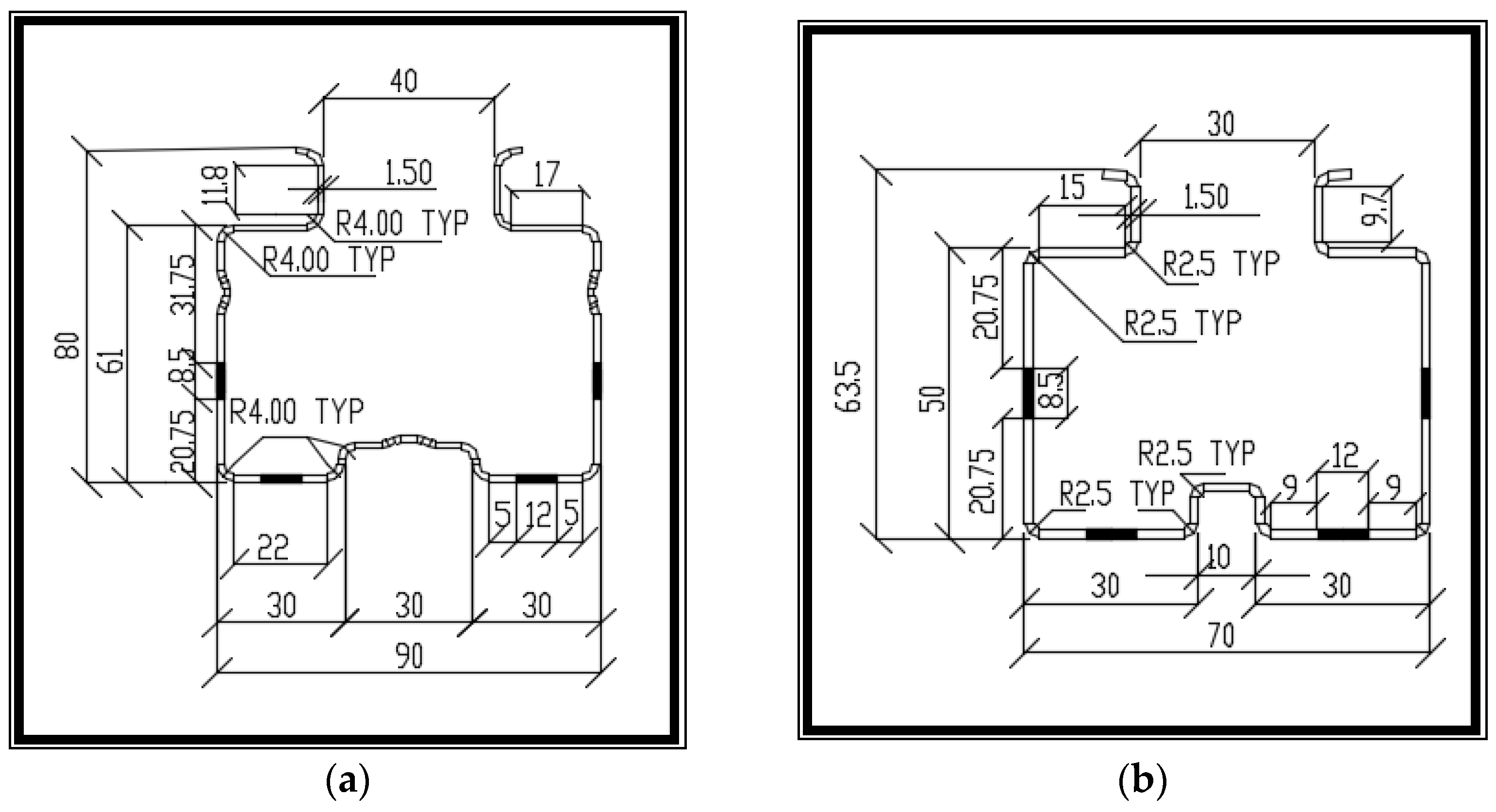

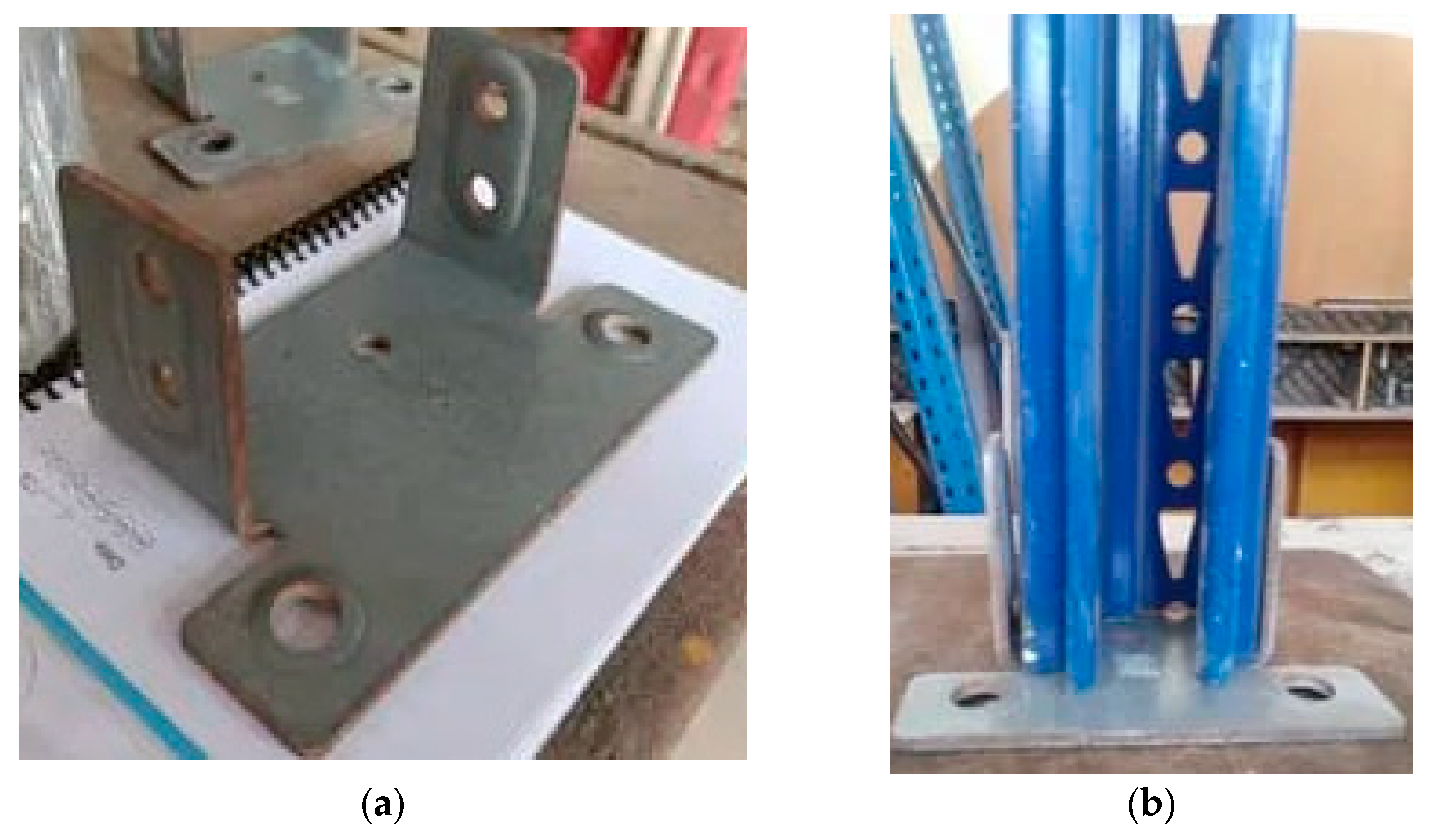
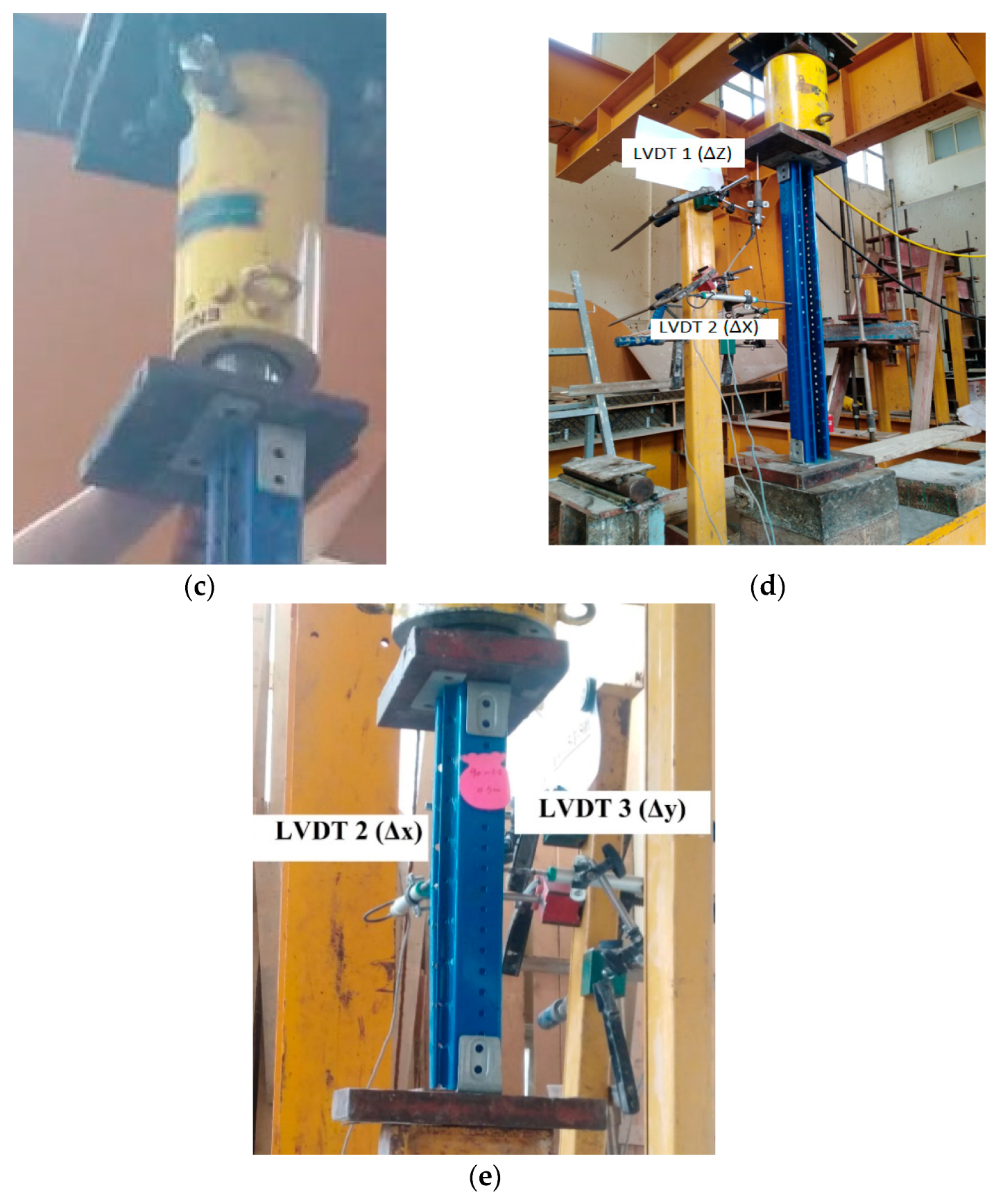
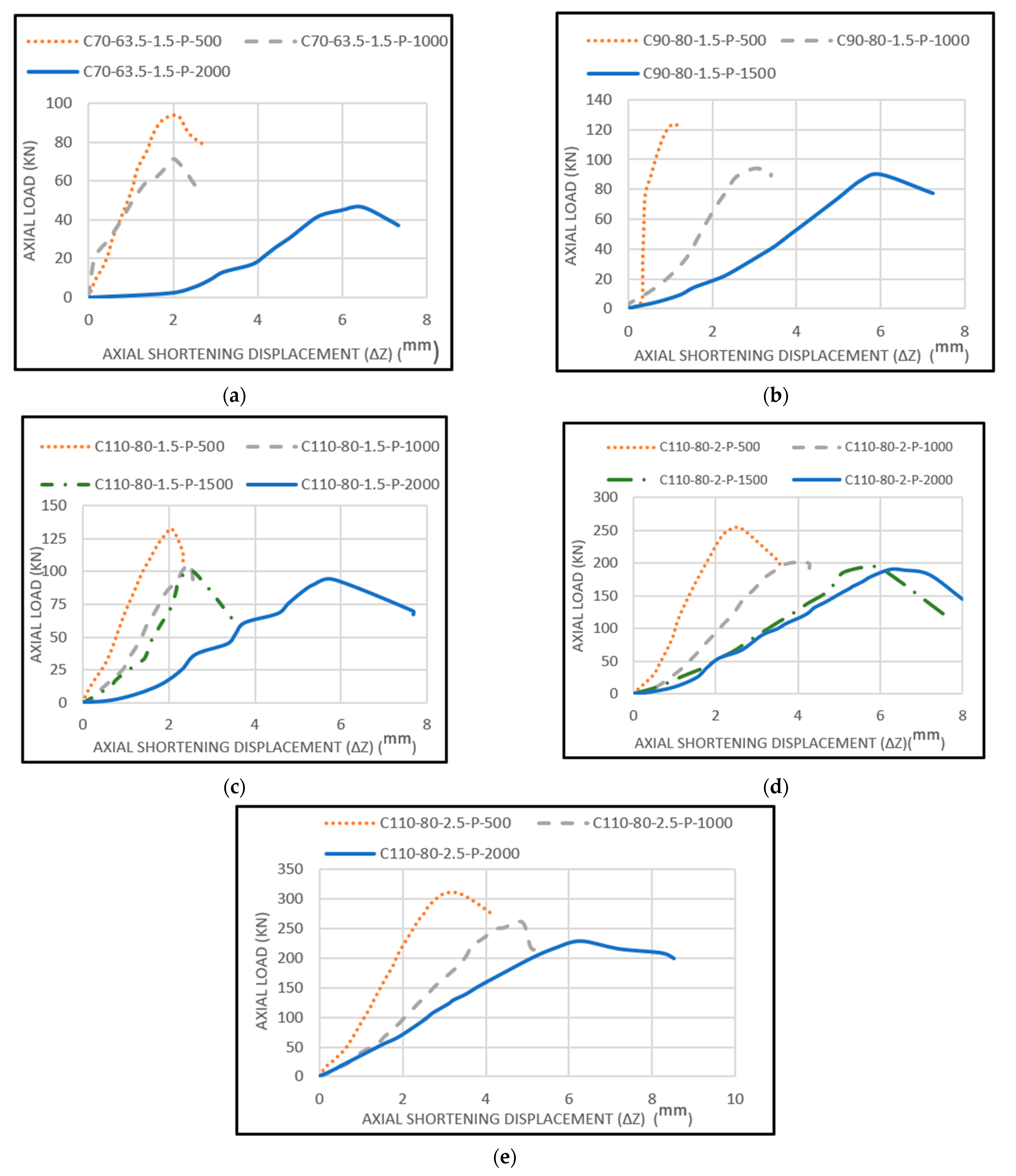
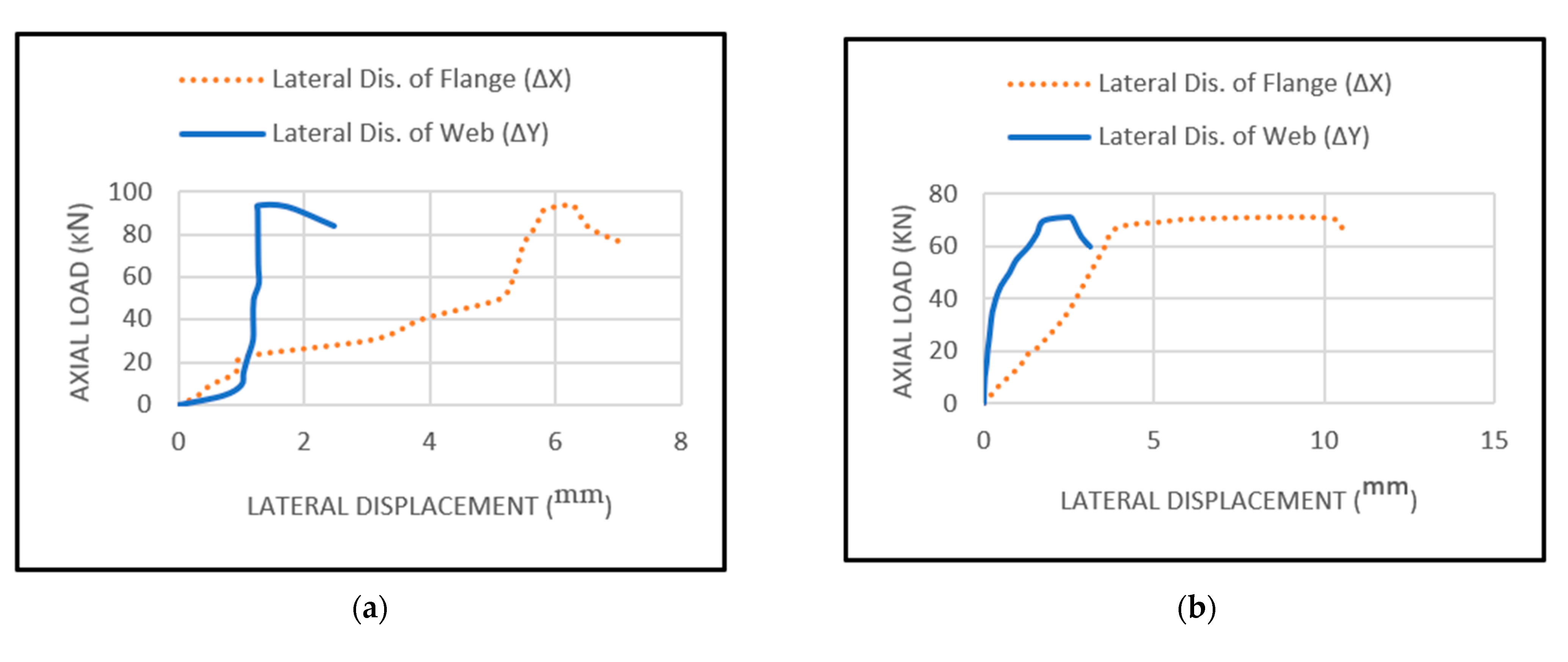

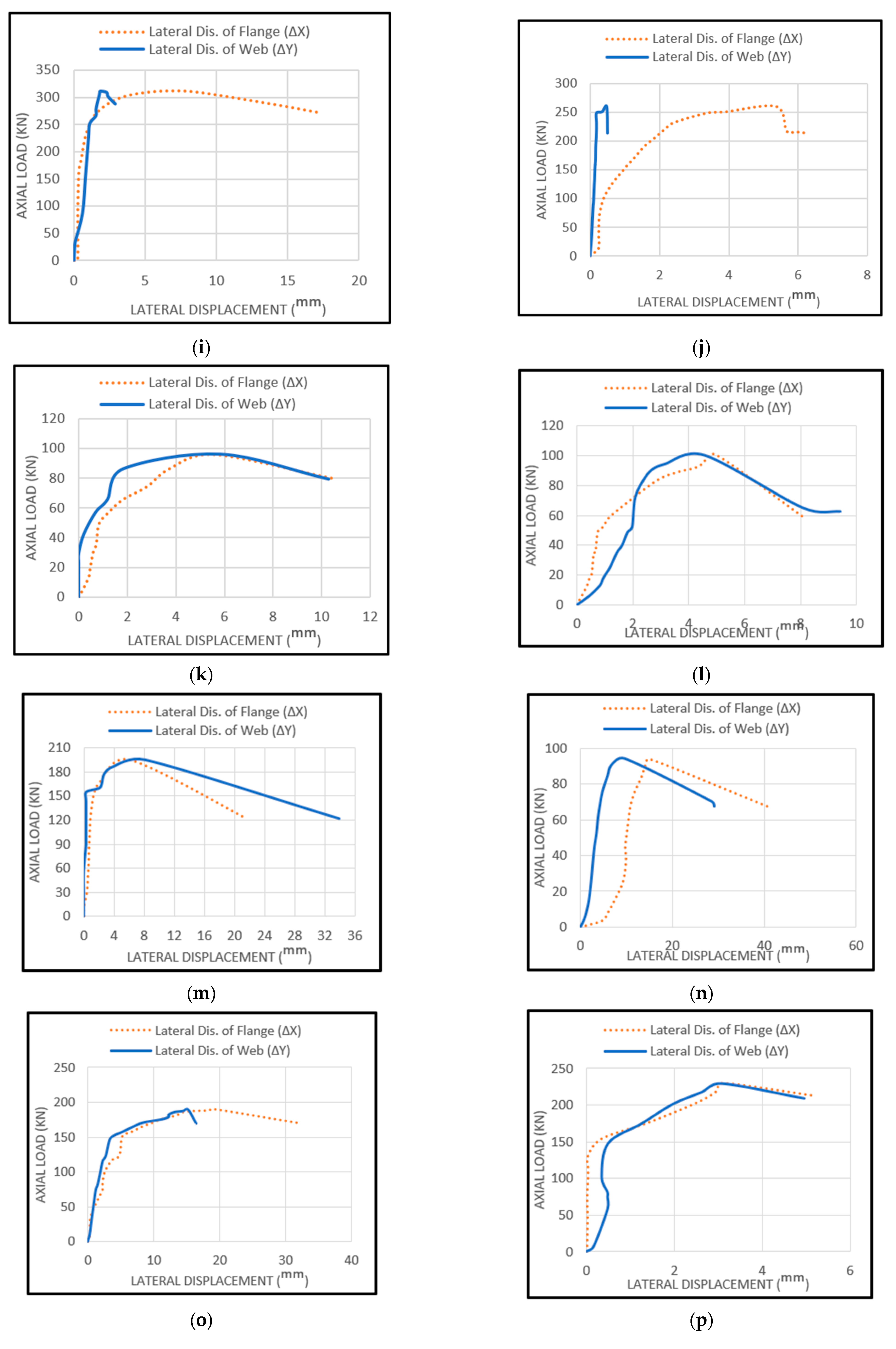
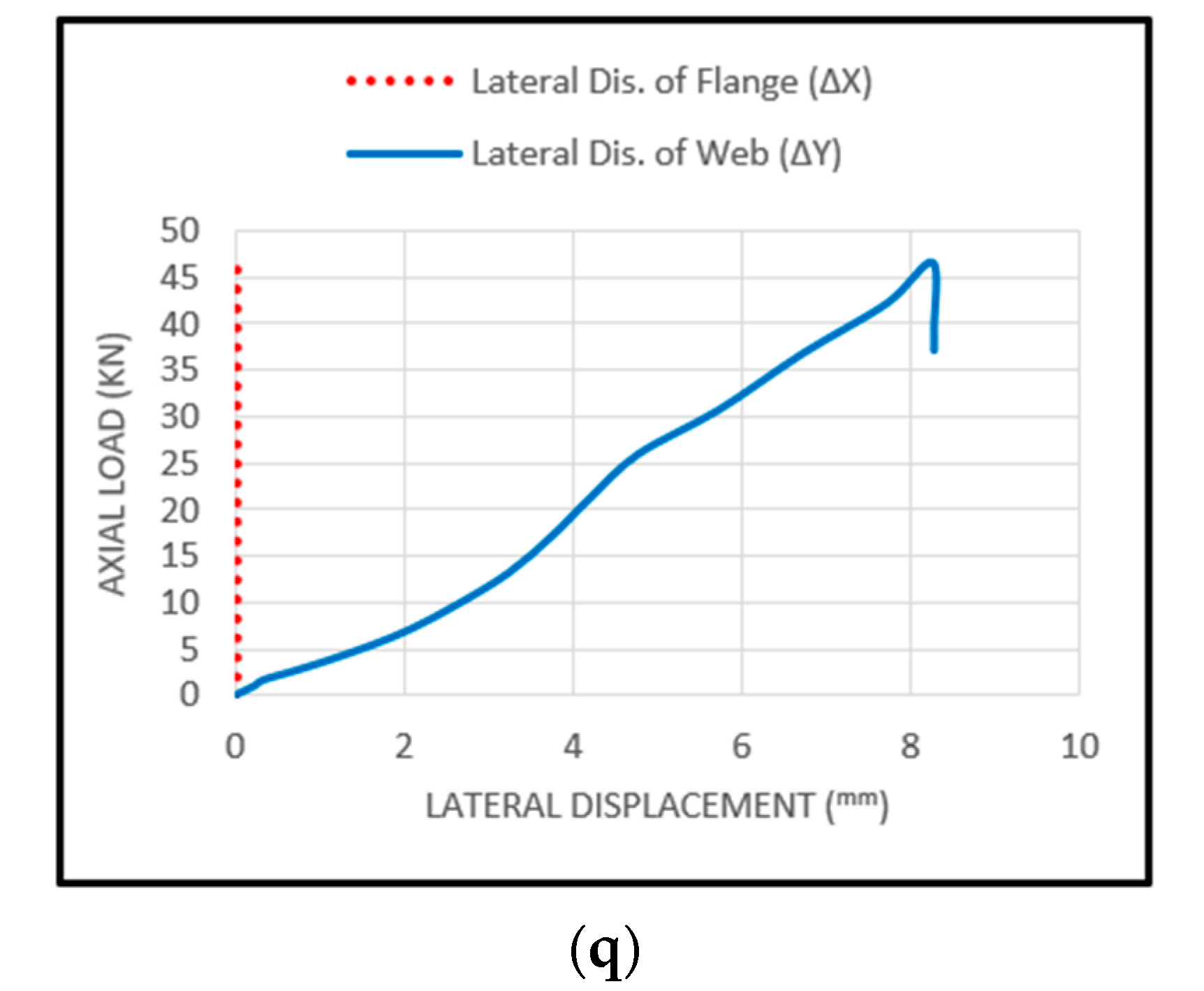
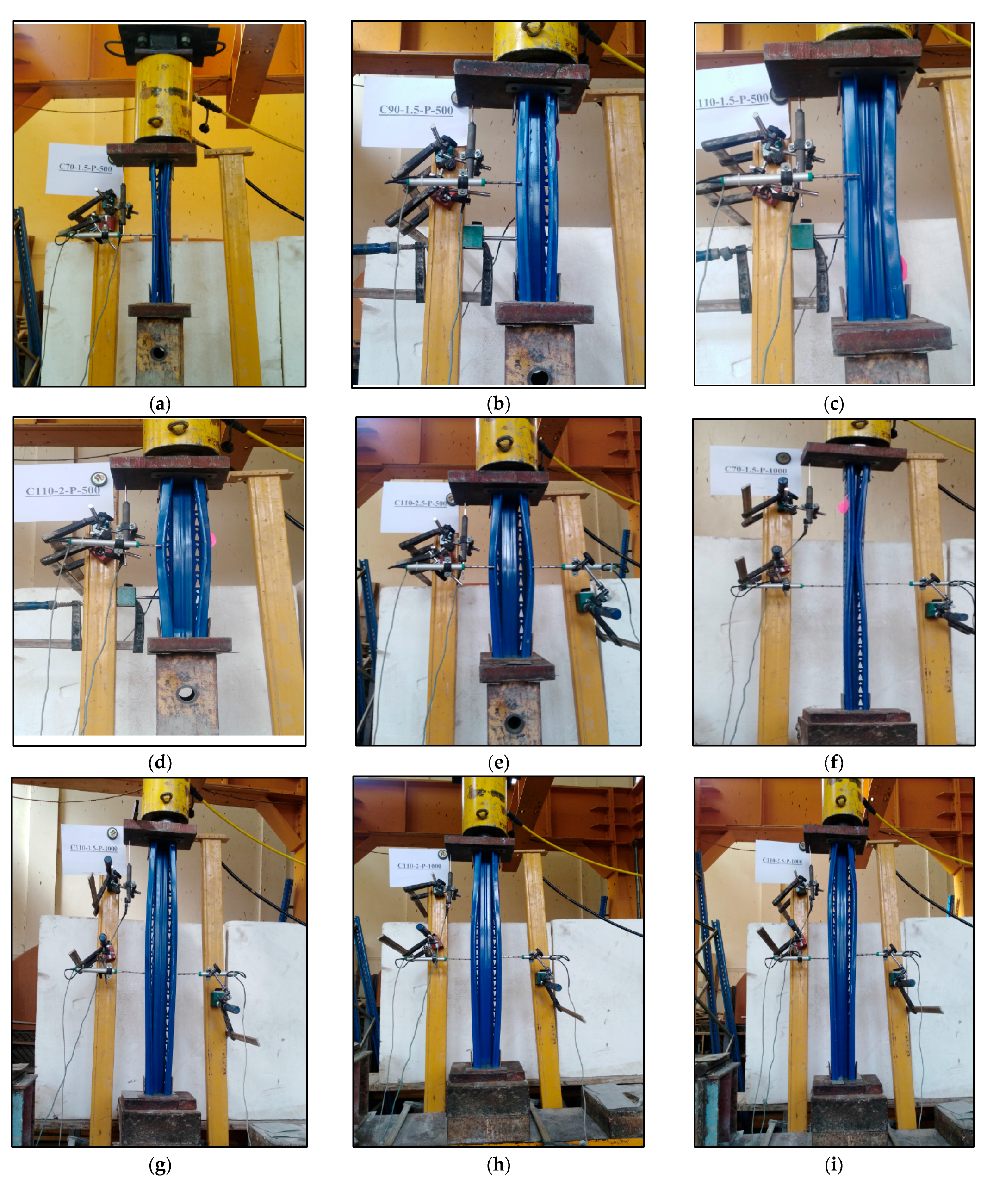
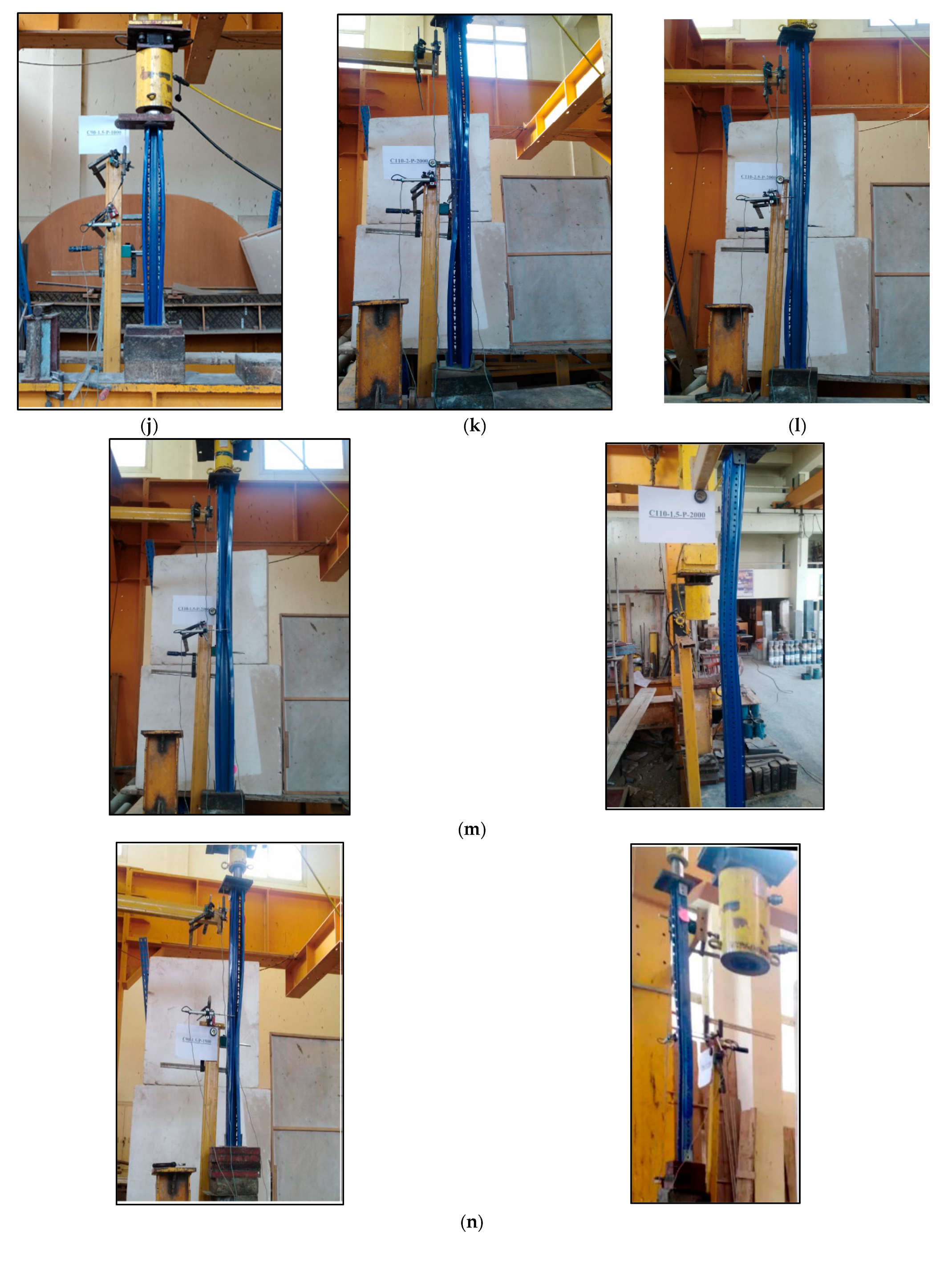
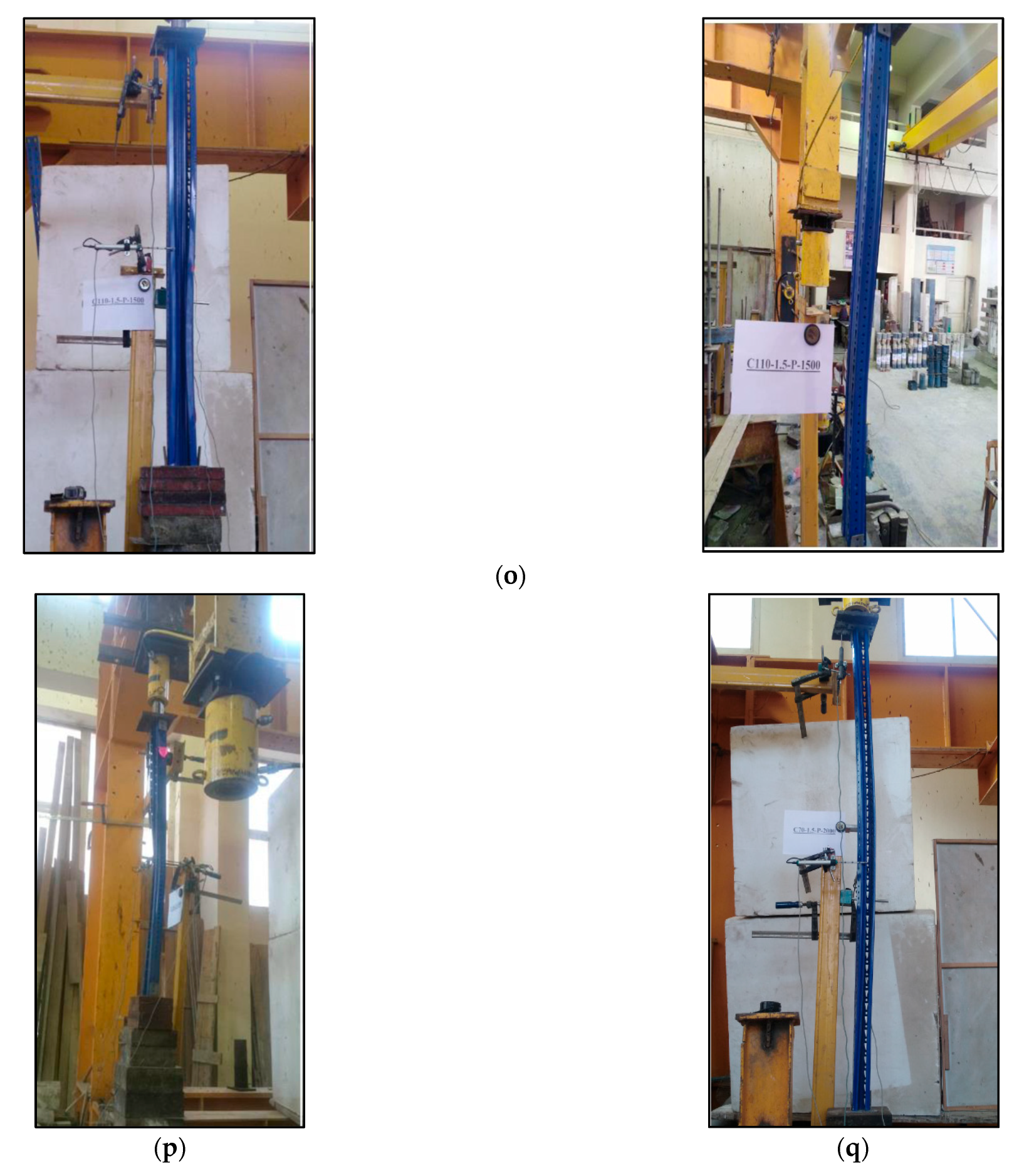
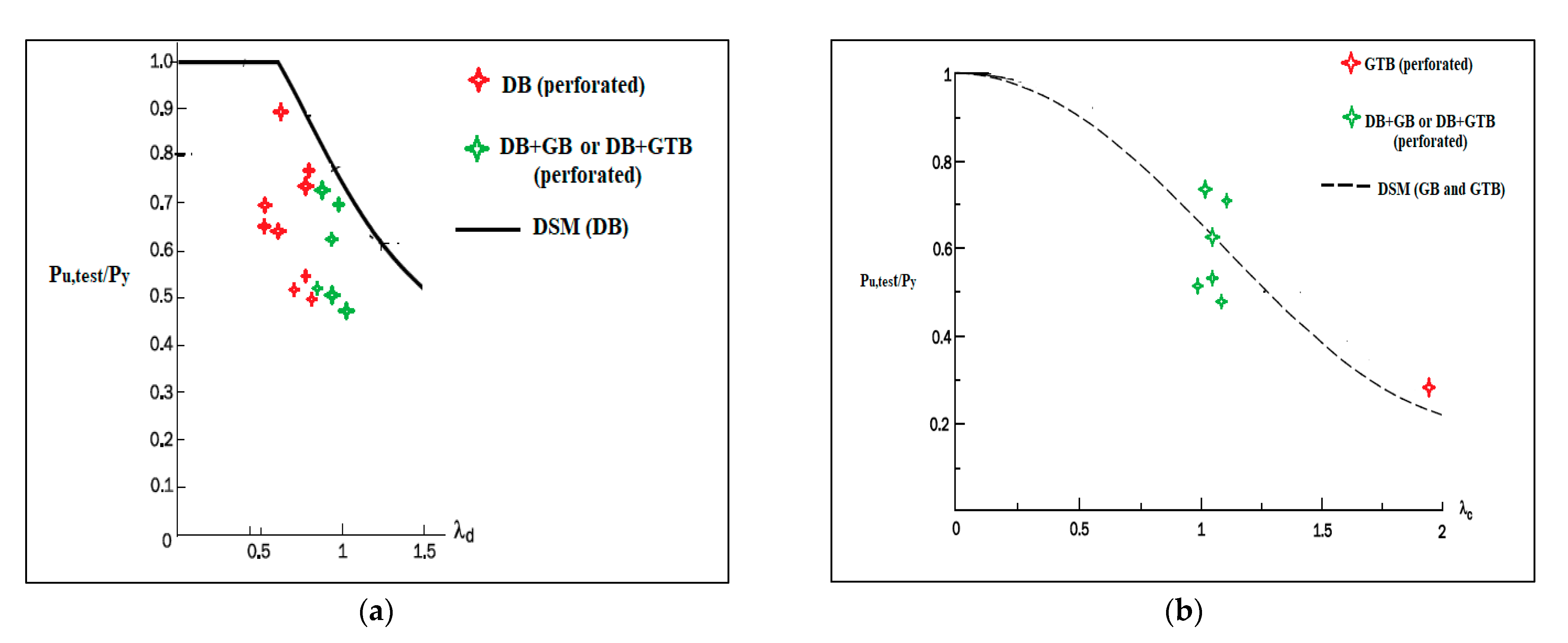

| The Thickness of the Material, t (mm) | Non-Perforated Coupon | Coupon with Circular Perforations from Flange | Coupon with Triangular Perforations from Web | Final Material Properties | ||||||||
|---|---|---|---|---|---|---|---|---|---|---|---|---|
| Fy (MPa) | Fu (MPa) | E (GPa) | Fy (MPa) | Fu (MPa) | E (GPa) | Fy (MPa) | Fu (MPa) | E (GPa) | Fy (MPa) | Fu (MPa) | E (GPa) | |
| 1.50 | 377 | 480 | 203.8 | 389 | 488 | 204.1 | 399 | 490 | 204.2 | 388 | 486 | 204.1 |
| 2.00 | 386 | 485 | 203.5 | 401 | 493 | 203.9 | 410 | 496 | 204.0 | 399 | 491 | 203.8 |
| 2.50 | 387 | 487 | 204.0 | 402 | 495 | 204.1 | 412 | 500 | 204.2 | 400 | 494 | 204.1 |
| Specimen | hw (mm) | bf (mm) | t (mm) | Length L (mm) | A g (mm2) | A (net) (mm2) | rx (net) (mm) | ry (net) (mm) | λx | λy | λmax |
|---|---|---|---|---|---|---|---|---|---|---|---|
| C70-63.5-1.5-P-500 | 70 | 63.5 | 1.5 | 500 | 370.7 | 323 | 22.34 | 26.14 | 22.38 | 19.12 | 22.38 |
| C70-63.5-1.5-P-1000 | 70 | 63.5 | 1.5 | 1000 | 370.7 | 323 | 22.34 | 26.14 | 44.76 | 38.25 | 44.76 |
| C70-63.5-1.5-P-2000 | 70 | 63.5 | 1.5 | 2000 | 370.7 | 323 | 22.34 | 26.14 | 89.52 | 76.5 | 89.52 |
| C90-80-1.5-P-500 | 90 | 80 | 1.5 | 500 | 455.4 | 407.7 | 27.01 | 33.80 | 18.51 | 14.79 | 18.51 |
| C90-80-1.5-P-1000 | 90 | 80 | 1.5 | 1000 | 455.4 | 407.7 | 27.01 | 33.80 | 37.02 | 29.59 | 37.02 |
| C90-80-1.5-P-1500 | 90 | 80 | 1.5 | 1500 | 455.4 | 407.7 | 27.01 | 33.80 | 55.54 | 44.38 | 55.54 |
| C110-80-1.5-P-500 | 110 | 80 | 1.5 | 500 | 510.9 | 463.2 | 26.96 | 40.89 | 18.54 | 12.22 | 18.54 |
| C110-80-1.5-P-1000 | 110 | 80 | 1.5 | 1000 | 510.9 | 463.2 | 26.96 | 40.89 | 37.09 | 24.45 | 37.09 |
| C110-80-1.5-P-1500 | 110 | 80 | 1.5 | 1500 | 510.9 | 463.2 | 26.96 | 40.89 | 55.63 | 36.68 | 55.63 |
| C110-80-1.5-P-2000 | 110 | 80 | 1.5 | 2000 | 510.9 | 463.2 | 26.96 | 40.89 | 74.18 | 48.91 | 74.18 |
| C110-80-2-P-500 | 110 | 80 | 2 | 500 | 678.4 | 614.8 | 26.87 | 40.60 | 18.61 | 12.32 | 18.61 |
| C110-80-2-P-1000 | 110 | 80 | 2 | 1000 | 678.4 | 614.8 | 26.87 | 40.60 | 37.22 | 24.63 | 37.22 |
| C110-80-2-P-1500 | 110 | 80 | 2 | 1500 | 678.4 | 614.8 | 26.87 | 40.60 | 55.82 | 36.95 | 55.82 |
| C110-80-2-P-2000 | 110 | 80 | 2 | 2000 | 884.4 | 614.8 | 26.87 | 40.60 | 74.43 | 49.26 | 74.43 |
| C110-80-2.5-P-500 | 110 | 80 | 2.5 | 500 | 884.4 | 764.9 | 26.78 | 40.31 | 18.67 | 12.40 | 18.67 |
| C110-80-2.5-P-1000 | 110 | 80 | 2.5 | 1000 | 884.4 | 764.9 | 26.78 | 40.31 | 37.34 | 24.81 | 37.34 |
| C110-80-2.5-P-2000 | 110 | 80 | 2.5 | 2000 | 884.4 | 764.9 | 26.78 | 40.31 | 74.68 | 49.62 | 74.68 |
| Specimen | λmax | hw/t | bf/t | Ix (net) (mm4) | Iy (net) (mm4) | Ip (net) = Ix (net) + Iy (net) (mm4) | Py = Fy*Anet (kN) | Pu,(exp) (kN) | Pu,(exp). Py | Failure Mode |
|---|---|---|---|---|---|---|---|---|---|---|
| C70-63.5-1.5-P-500 | 22.38 | 46.6 | 42.3 | 1.6 × 105 | 2.2 × 105 | 3.8 × 105 | 125.3 | 93.6 | 0.75 | (DB) |
| C70-63.5-1.5-P-1000 | 44.76 | 71.4 | 0.57 | (DB) | ||||||
| C70-63.5-1.5-P-2000 | 89.52 | 46.6 | 0.37 | (GTB) | ||||||
| C90-80-1.5-P-500 | 18.51 | 60 | 53.3 | 2.9 × 105 | 4.6 × 105 | 7.6 × 105 | 158.17 | 123.5 | 0.78 | (DB) |
| C90-80-1.5-P-1000 | 37.02 | 93.8 | 0.6 | (DB) | ||||||
| C90-80-1.5-P-1500 | 55.54 | 90.1 | 0.57 | (DB + GB) | ||||||
| C110-80-1.5-P-500 | 18.54 | 73.3 | 53.3 | 3.3 × 105 | 7.7 × 105 | 11.1 × 105 | 179.72 | 132.3 | 0.74 | (DB) |
| C110-80-1.5-P-1000 | 37.09 | 105.3 | 0.59 | (DB) | ||||||
| C110-80-1.5-P-1500 | 55.63 | 100.4 | 0.56 | (DB + GB) | ||||||
| C110-80-1.5-P-2000 | 74.18 | 94.1 | 0.53 | (DB + GB) | ||||||
| C110-80-2-P-500 | 18.61 | 55 | 40 | 4.4 × 105 | 10 × 105 | 1.4 × 106 | 245.28 | 253 | 1.03 | (D.B.) |
| C110-80-2-P-1000 | 37.22 | 201.9 | 0.82 | (DB) | ||||||
| C110-80-2-P-1500 | 55.82 | 195.6 | 0.8 | (DB + GB) | ||||||
| C110-80-2-P-2000 | 74.43 | 190.1 | 0.77 | (DB + GTB) | ||||||
| C110-80-2.5-P-500 | 18.67 | 44 | 32 | 5.4 × 105 | 1.2 × 106 | 1.7 × 106 | 305.96 | 311.5 | 1.02 | (D.B.) |
| C110-80-2.5-P-1000 | 37.34 | 260.8 | 0.86 | (DB) | ||||||
| C110-80-2.5-P-2000 | 74.68 | 229.5 | 0.75 | (DB + GTB) | ||||||
| Mean | 0.712 | |||||||||
| Standard Deviation | 0.177 | |||||||||
| COV | 0.040 | |||||||||
| Specimen | Pu,exp (kN) | Pn,DSM (kN) | Pn,DSM./Pu,exp | Experimental Failure Mode | DSM Failure Mode |
|---|---|---|---|---|---|
| C70-63.5-1.5-P-500 | 93.6 | 112.1 | 1.2 | DB | LB |
| C70-63.5-1.5-P-1000 | 71.4 | 100.9 | 1.4 | DB | LB |
| C70-63.5-1.5-P-2000 | 46.6 | 32.9 | 0.7 | GTB | LB |
| C90-80-1.5-P-500 | 123.5 | 145.2 | 1.2 | DB | LB |
| C90-80-1.5-P-1000 | 93.8 | 138.6 | 1.5 | DB | LB |
| C110-80-1.5-P-500 | 132.3 | 163.1 | 1.2 | DB | LB |
| C110-80-1.5-P-1000 | 105.3 | 125.9 | 1.2 | DB | LB |
| C110-80-1.5-P-2000 | 94.1 | 98.38 | 1.04 | DB + GB | LB |
| C110-80-2-P-500 | 253 | 209.3 | 0.8 | DB | LB |
| C110-80-2-P-1000 | 201.9 | 180.4 | 0.9 | DB | LB |
| C110-80-2-P-2000 | 190.1 | 132.3 | 0.7 | DB + GTB | LB |
| C110-80-2.5-P-500 | 311.5 | 272.7 | 0.9 | DB | LB |
| C110-80-2.5-P-1000 | 260.8 | 228.7 | 0.9 | DB | LB |
| C110-80-2.5-P-2000 | 229.5 | 183.7 | 0.8 | DB + GTB | LB |
Publisher’s Note: MDPI stays neutral with regard to jurisdictional claims in published maps and institutional affiliations. |
© 2022 by the authors. Licensee MDPI, Basel, Switzerland. This article is an open access article distributed under the terms and conditions of the Creative Commons Attribution (CC BY) license (https://creativecommons.org/licenses/by/4.0/).
Share and Cite
Shaker, F.M.F.; Mamdooh, Z.; Deifalla, A.; Yehia, M.M. Experimental Investigations of the Behavior of Stiffened Perforated Cold-Formed Steel Sections Subjected to Axial Compression. Buildings 2022, 12, 812. https://doi.org/10.3390/buildings12060812
Shaker FMF, Mamdooh Z, Deifalla A, Yehia MM. Experimental Investigations of the Behavior of Stiffened Perforated Cold-Formed Steel Sections Subjected to Axial Compression. Buildings. 2022; 12(6):812. https://doi.org/10.3390/buildings12060812
Chicago/Turabian StyleShaker, Fattouh M. F., Zekriat Mamdooh, Ahmed Deifalla, and Mohamed M. Yehia. 2022. "Experimental Investigations of the Behavior of Stiffened Perforated Cold-Formed Steel Sections Subjected to Axial Compression" Buildings 12, no. 6: 812. https://doi.org/10.3390/buildings12060812







